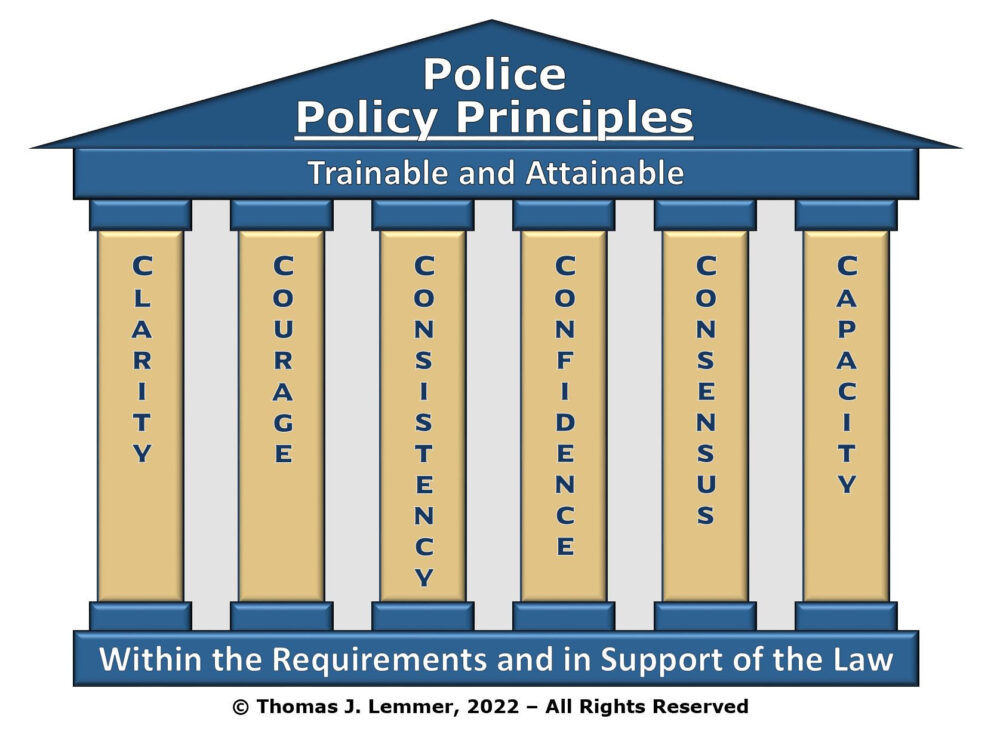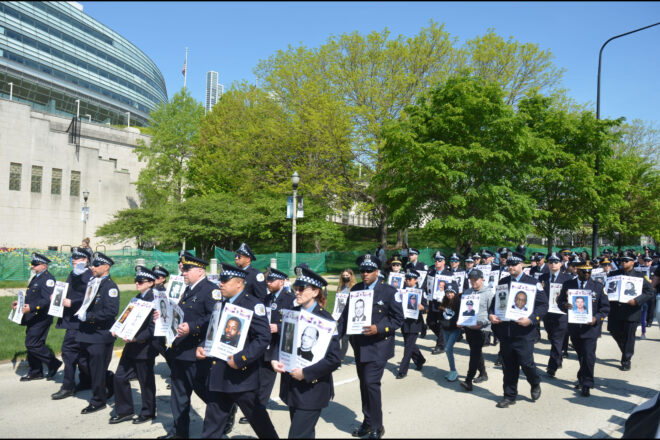Leadership is always a much discussed topic and concern within the law enforcement profession. Leadership is a complex and dynamic topic. In such discussions, the styles of those tasked with leadership responsibilities are often the primary focus. Yet there is style, which is important, and then there is substance. Often overlooked are the mechanics of the formal leadership processes that guide the functions and operations of an agency. If a chef’s recipes can make or break a restaurant, which they can, so too should we view the policies of a police agency. A bad recipe can leave a bad taste, or worse. A bad policy can undermine a department’s operations, or worse – much worse.
Estimated reading time: 23 minutes
Bad policies can destroy officer morale, misdirect resources, complicate procedures, create inefficiencies, and impede effectiveness. Bad policies can cost millions in civil damages, litigation defense, and remediation efforts. In policing, officer safety should always be a priority concern, and bad policies can, and do, place individual members at risk. Bad policies can cost lives. Bad policies can also undermine the very public safety mission of a police department. Even as all of this is true, policy development is often foolishly approached much like art. The untrained observer is left to just know supposedly good policy when they see it. Such is a recipe for disaster. Thankfully, there is a better approach for police policy development.
Police Policy Overview of Terms
Since 1893, the International Association of Chiefs of Police (IACP) has sought to serve communities “by speaking out on behalf of law enforcement and advancing leadership and professionalism in policing worldwide.” For more than 20 years, I have been a member of the IACP, which overall now has more than 32,000 members from 168 countries. The association’s Law Enforcement Policy Center was created to identify leading practices, which provide guidance for the profession, and “assist in developing policies for individual departments.”
The IACP’s written directives sample policy provides four key terms that directly relate to this important discussion. They are:
- Policies – which “summarize the department’s position on specific matters. Policies are concise position statements based on underlying organizational principles, goals, values, and operational philosophies. They are designed for broad general direction and guidance primarily designed for use by all members of the department or by more than one operational division.“
- Procedures – which “build on the foundation of policy statements to provide specific guidance on required, desired, or preferred methods of operations or conduct. Procedures are more detailed instruction on means and methods for carrying out the policy directive and generally draw the boundaries of permissible officer discretion in performing specific tasks or duties.“
- Rules – which “define situations where no deviation or exceptions to agency-authorized actions are permitted.” Rules are differentiated from procedures, which “often provide officer flexibility and discretion,” where as “rules are characterized by their inflexibility.“
- Written directives – “are position statements by or authorized through the chief executive officer (CEO) that guide or direct the actions and activities of officers. Directives encompass all means by which this agency communicates instructions, orders and duty requirements to its members, to include policies, procedures, rules, regulations, general orders, special orders, memoranda, and instructional materials.”
In considering the relationship between these terms, as defined above, “policies” drive the process. It is from the policies of a department that its rules and procedures take form, and they are then formally disseminated across the agency through its written directives. Without question, the policing profession is one that relies heavily on formally defined and promulgated policies. Even the smallest law enforcement agencies have policies covering a wide range of operational and administrative topics, with many procedures, rules and directives.
Lemmer’s Six Pillars of Police Policy
This training insight, on the topic of police policy, has been prepared to provide guidance on how agencies can ensure that their policy development processes are properly focused and are based upon sound principles. There are three essential police policy principles. Each law enforcement agency should ensure that all of its policies (and their associated procedures, rules, and written directives):
- Rest upon a foundation that is both consistent with and supports the law.
- Are focused on setting the best possible trainable and attainable standards.
- Embrace six core pillars: Clarity, Courage, Consistency, Confidence, Consensus and Capacity.

The model presented here begins from a fundamental point. In America, all police policies must be built from a foundation of the United States Constitution, as well as all other requirements of the law binding on the respective agency. The overwhelming majority of our nation’s law enforcement agencies operate under the jurisdiction of one of America’s fifty states. For those agencies, their corresponding state constitution is also within its core foundational bedrock. The central importance of these constitutional commitments is reflected in the fact that each officer swears an oath of allegiance to them. On this point, the implementation of police policies must always allow an agency’s personnel to maintain unbroken fidelity to their sworn oaths, while following the guidance provided by their agency and its leaders.
Secondly, the identified principles and supporting pillars should be understood as being essential in the effort to establish best practice policies that enhance an agency’s ability to meet its public safety mission. Policies that weaken the ability of an agency to meet its core mission are not best practice. It is essential that police executives view the policy development process from the context of two key perspectives. Externally, the policies established by police agencies must be simultaneously respectful of individual liberty and civil rights, while also fostering public safety. Internally, our law enforcement agencies must establish policies that are consistent with professional standards, as well as all collective bargaining agreements that govern the employer-employee relationship with their members. Being mindful of the rights of our police officers is an essential component in ensuring our officers are respectful of the rights of others. In a constitutional republic, the level of safety in the community is directly correlated to the strength of the police-community relationship. Best practice police policies legitimately foster both public and officer safety.
Third, each of the six identified pillars within the third principle, should also be understood as providing essential support to the other pillars. A failure of a policy to meet any one of the pillars weakens the policy overall. Absent the strength provided by any one of the pillars has a likely negative impact on the agency’s ability to adhere to the others. Consistency is not possible without clarity. Capacity is reduced in the absence of confidence, and consensus suffers in the absence of courage. Fortunately, the positive impact of each of the principles helps to buttress the others. Courage in addressing the core issues necessitating a policy can build confidence in the subsequent approaches established under that policy. Clarity within a policy can foster the level of consistency in its implementation. The capacity of the agency to meet its obligations under a policy can enhance the level of confidence in that same policy. While each of the pillars has merit on its own, the combination of the six pillars is greater than the sum value of the pillars individually.
Fourth, police policy development should never be a theoretical exercise. Policies that are altered or established simply to placate external audiences or “paper over” operational issues are ultimately harmful to the credibility of the agency, weaken the ability of the agency to meet its mission, and can place the agency’s personnel in severe jeopardy administratively, legally, and physically. Additionally, it is a core responsibility of police executives and public officials to ensure that our police officers are never confronted with circumstances in which adherence to a policy places them in opposition with community expectations relative to public safety, the law, or their sworn oaths. All such flawed policies are fundamentally failures of leadership. At their core, an agency’s policies must be realistic and facilitate the proper completion of the essential work of the profession. In short, police policies must be trainable, and they must establish procedures, standards, and expectations that are appropriately and reasonably attainable by the agency’s personnel.
The structure of the identified principles and six pillars is intended to cover the full scope of the topic, but in a manner that facilitates both understanding and offers an ease of application. Each of the pillars is defined and briefly described below.
Clarity
Relative to understanding and perception, clarity is the presence of clearness or lucidity. Clarity eliminates ambiguity. In policing, doubt and uncertainty greatly increase the risk of errors, unintended outcomes, even tragedies. With clarity, a policy provides guidance that is direct, and the standards and expectations established through a clearly written policy are easily understood. The central function of any policy is to answer the core who, what, when, where, why and how questions related to an issue. Depending on the issue, the order of the questions may change and the level of emphasis on the specific questions may take on greater or lesser importance. Yet, relative to policy development, clarity in answering the core questions is always desired.
While integral to the process, the ability to attain clarity can be exceptionally challenging depending upon the complexity of the issue and the level of complicating influences at hand. It is easier to create a policy that can be reliably understood, recalled, and implemented when considering six factors as opposed to sixty. However, as the complexity of an issue increases, so too does the need for the policy to provide guidance that is understood. Absent understanding, the policy is without value.
As described above, each of the six pillars supports and is supported by the other pillars, and in this respect the pillars are of equal importance. Yet, clarity can reasonably be viewed as being the first among these equals. Without clarity, the ability to fully attain the other pillars is substantially weakened. Rather than courage, consistency, confidence, consensus and capacity, the absence of clarity breeds apprehension, miscalculations, confusion, discord, and lethargy – even paralysis. It is in these respects that a lack of clarity can cause the most damaging policy failures.
Courage
Courage follows directly after clarity, as ensuring that clarity exists within an agency’s policies is a core leadership responsibility often requiring courage. The dictionary defines courage as: “the quality of mind or spirit that enables a person to face difficulty, danger, pain, etc., without fear.” Improving upon that definition, courage is most evident when one presses forward despite fear. Within the law enforcement profession, courage is appropriately first associated with the physical dangers faced by our officers, deputies, troopers, agents and other members carrying out their agency’s public safety mission directly in the field. But administrative courage is also a key factor within the profession, as well as its opposite – supervisory cowardice.
Depending on the particular policy issue, ensuring that an agency’s policies are properly founded on the constitution; safeguard civil liberties; provide clarity and consistency; build confidence, consensus and capacity; and establish the appropriate and reasonable trainable and attainable standards can be challenging. Such can even generate substantial political pressures for and from elected officials with authority over the agency and carry liability and career risks for police executives.
A law enforcement agency’s leaders must demonstrate the courage necessary to develop the policies that both address the issues of concern and do so in the manner that advances the mission of the agency. Police executives must meet their policy challenges acknowledging that both public and officer safety are priority concerns. Ensuring public safety requires the members of a law enforcement agency to undertake duties that can expose them to grave personal danger in defense of the innocent, vulnerable, and overall community. Fostering officer safety and wellness acknowledges those inherent dangers and advances policies, techniques, strategies, and support services that maximize the individual officer and agency capacity to confront the risks and survive.
As leadership is crucial in this regard, police executives must ensure that policy development and actual implementation efforts are not deterred or misdirected by misconduct, corruption, or inappropriate political influences. So too must agency leaders ensure that all policy issues that fail to meet the highest professional standards are properly addressed. Supervisory courage is required to ensure that personnel are supported and appropriately monitored in the proper implementation of the agency’s policies. Officers must demonstrate courage in the performance of their duties in a manner that simultaneously enhances public safety, defends individual liberty, secures civil liberties, honors their oaths, adheres to the highest professional standards, and is consistent with the policies of their agencies. They must also have the courage to inform their leaders of unaddressed or improperly addressed issues – and, when necessary, prioritize their obligations to constitutional policing over flawed policies that endanger the community.
Consistency
Consistency is an adherence to the same principles, course of action, and procedures when under similar conditions or circumstances. Again, as described above, all police policies rest upon a foundation of the constitution and the law. Key among the factors to be considered in the development of a police policy are the requirements and limitations of the law. Each policy must be consistent with the laws that correspond to the circumstances at hand, and all applicable collective bargain agreements between the involved department and its members. Fair and equal treatment under the law requires a commitment to consistency, both overall as an objective of the involved agencies of the criminal justice system, and specifically within the law enforcement agencies tasked with advancing public safety.
Police policy efforts must maintain a focus on enhancing the agency’s consistency in its techniques, tactics, and strategies utilized to meet its goals and objectives. The approaches directed by an agency must seek balance within the range of circumstances that any specific policy addresses. Best practice policies must be appropriately scalable to the specifics of the incident then at hand – yet similar across all incidents identifiable as resting in proximity to each other along the scale. For example, relative to an agency’s use of force policy, incidents requiring only verbal direction are approached similarly to each other, yet they are also distinguishable from incidents that, while involving verbal direction, require physical and even deadly force. The principle of consistency requires appropriate logic and reason for the necessity of variation allowed under the policy based upon the facts and circumstances then encountered.
Consistency, also requires consideration of the individual policy statement (and subsequent directives operationalizing that policy) and the other policies (and directives) of the agency. The various policies must not establish conflicting instruction, guidance, and requirements upon those tasked with carrying out the various elements of any one policy. The best policies provide consistency between interpretation and actual implementation by the agency’s personnel, and allow those officers to both follow the policy and fully meet their public safety mission and the obligations of their oaths.
Confidence
Confidence is a key relational assessment concerning believability, reliability, certainty, and trustworthiness. A policy cannot have confidence, but the policies of an agency should inspire confidence on multiple levels. An agency’s policies should provide assurance that the specified approaches, procedures, strategies, and objectives are well-reasoned, and that they will appropriately advance the mission of the organization. While no policy can direct the actions of individuals not working within the involved organization, the policies of every law enforcement agency should foster confidence both internally among the agency’s members and externally with the public, community stakeholders, other agencies, the courts, and elected officials.
Within the organization, each policy should be crafted such that the members of the organization take on the challenges of their assignments and do the work needing to be done where, when and how needed. As an agency’s officers and supervisory personnel take on the responsibilities and risks that are incumbent upon them, the relevant policies should reasonably foster confidence in their implementation. Policies that are unclear, ignore operational complexities, lessen agency effectiveness, place officers in conflict with their oaths, and needlessly raise administrative, liability, and safety risks cannot reasonably be expected to establish the internal agency confidence necessary for successful policy implementation.
Beyond the organization, each policy should be crafted such that its full implementation does not place the agency’s members in conflict with the law and the courts. The policies of an agency with a public safety mission should strengthen (or at minimum, not weaken) the active support for the agency and its members from the community, civic leaders, and elected officials. Without question public safety is directly tied to the strength of the police-community relationship. Police policy development efforts must proceed with an intentional focus on the profession’s need for community support.
Transparency and proactive engagement efforts relative to police policy development efforts are essential. It is a responsibility of police executives and elected officials to foster truthful communication relative to the complexities of policing, and the appropriateness of various policing techniques, approaches, and strategies. Those in leadership positions must also express their commitment to constitutional policing, as well as their dedication to appropriately addressing community expectations and concerns regarding public safety, errors, misconduct, and tragedy. The community is correct to expect both constitutional policing and public safety. However, elected officials and police executives are reminded that policies which weaken an agency’s ability to appropriately address crime conditions neither enhance public safety nor inspire community support. Community confidence in policing can be strengthened through the implementation of agency policies that are reflective of the principles identified under this model.
Consensus
Consensus occurs when there is general agreement, a majority of opinion, on a topic. When several knowledgeable and skilled professionals consider the intricacies of an issue, responses to that issue can be enhanced. During the policy development process, police executives can look to other agencies for guidance on the general professional standard on a wide array of topics. As previously mentioned, the IACP and other professional associations are also readily available sources for the consensus view of key approaches, procedures, techniques, and strategies. Such is particularly the case with the most critical policies. Legal distinctions between the various jurisdictions can create key policy variations, but overall core elements of the highest-risk policies are recognizable across a great many agencies. Such professional consensus can help build confidence in the subsequent policy and the related approaches established by an agency.
When there is internal agency consensus, policy implementation flows more easily and operational outcomes are more likely to follow the established guidelines. This is especially true when there is agreement between leadership and the line personnel tasked with carrying out the policy. As such, on this level alone, consensus is a highly-valued principle. Here again, leadership is key to the legitimacy of the process and the strength of the final policy. Those directing the policy development process must actively seek out expertise and the practical experience that surrounds the issue under review. Internally, drafts of the policy should be circulated across all of the impacted units, with the resulting feedback reviewed for areas in need of revision. Externally, legal reviews are often necessary, and with potentially controversial policies, community engagement can be essential.
It is also important for police executives and elected officials to understand that the current consensus can be lacking. As it turns out, the earth is not flat. Additionally, shifts in consensus can be particularly vulnerable to highly-charged, tragic events with significant political implications. Courage is often required in such environments. There is a leadership obligation to build consensus around what is best practice, which may not be the current consensus. Best practice approaches are again built upon a foundation of constitutional policing and a prioritized commitment to both public and officer safety. Best practices are also mindful of and address local conditions, agency needs, as well as the skills, abilities and staffing limitations of the agency’s personnel. Consensus built from best practice policies allows an agency’s officers to do their work in a manner that promotes both an understanding of police operations and overall support within the community. Consensus around best practices helps to build confidence.
Capacity
Capacity is defined first as “the ability to receive or contain,” and second as “the maximum amount or number that can be received or contained.” Within these principles, capacity refers to the ability of: (1) an agency’s members to perform their duties, and (2) the agency overall to meet its mission. Excellence is the desired standard. Capacity is therefore an expression of how close the agency and its members are to excellence. An agency’s policies set forth the procedures, requirements, limitations, standards and expectations. From a policy development standpoint, an organization’s policies should enhance and expand the performance of its personnel and the agency overall. As such, policies that reduce an agency’s ability to meet its mission reduce its capacity, and they are not best practice. A low-performing agency has a limited capacity to meet its mission.
Capacity-reducing policies are costly. Policy capacity errors lay the groundwork for operational errors. In policing, errors can carry both monetary and human costs with tragic outcomes. As described above, bad police policies can destroy officer morale, misdirect resources, complicate procedures, create inefficiencies, and impede effectiveness. Bad police policies can cost lives. All of these undesired outcomes are among the potential consequences of policies that ignore the capacity principle. Each agency policy should help build the capacity of the agency overall and among its personnel to effectively perform the work of the agency. Doing so requires policies that maximize the ability of the agency to meet its crime prevention and public safety mission consistent with the demands of constitutional policing and consistent with informed community expectations.
This sixth pillar most directly underscores the need for the policy development process to have a trainable and attainable focus. Every law enforcement agency has an obligation to strive for the highest professional standards. Police executives have a primary duty to ensure the skill levels of the agency’s members are commensurate to the demands of their duties. As such, leadership must establish the protocols and training programs that help to build the capacity of the agency and foster policy compliance.
Pulling the Police Policy Principles Together
The principles provided in the model should convey the following additional key point. Police policy is not a one (or even a 100) and done process. The policy development process is an unending one. Even long-established policies require monitoring for the need to revise and update. Unforeseen factors come to light identifying policy gaps. Legislation, court rulings, and technological advances often impact the procedures to be followed by agency personnel. New variations to old issues emerge. Staff come and go creating compliance issues. New personnel need to be notified of the agency’s policies and trained to ensure their capacity to perform their duties consistent with expectations. The most critical policies – particularly those with potentially life and death consequences – must be the subject of constant discussion and training within the organization.
Those holding leadership positions must proactively undertake their policy development and implementation duties. They must engage both internally within the organization and externally with elected officials, community stakeholders, the media, and the public relative to their agency’s procedures, directives, and strategies. They must inform, educate, and continually assess the level of consensus around their agency’s policies. They must demonstrate courage by both defending best practice policies and revising failing ones. Police executives bear the primary responsibility for continually asking themselves the following questions regarding their agency’s policy process:
- Are our policies clear? Do our members know what is expected of them? How they are to respond? When they have discretion? When not?
- Am I and my senior staff displaying the courage needed? Are we addressing the issues needing to be addressed? Are we defending our best practice policies? Are our supervisors and members displaying the courage needed to fully and properly implement our directives?
- Are our policies consistent? Are we providing conflicting guidance across multiple directives? Do our policies reflect our adherence to the principles of constitutional policing? Are they in keeping with all legal mandates and limitations?
- Do our policies inspire confidence? Do they reflect the best practices within the profession? Do our members concur with the guidance, procedures, mandates, and limitations our directives establish? Is there community support for our agency’s goals, values, and strategies?
- Are our policies reflective of the professional consensus? Are our approaches data informed and evidence based? Is the agency proactively engaging the community, media, and elected officials relative to the best practice nature of our procedures, standards, and directives?
- Is the capacity of our agency enhanced by our policies? Do our directives allow for full policy compliance while also allowing our personnel to effectively meet the demands of their assignments? Are we able to meet our crime prevention, investigative, and public safety mission?
If the answers to the above questions, and others like them, reveal shortcomings, the responsible police executives must take action. Those in leadership roles must are also reminded that the best policies left unimplemented, unmonitored, and unenforced are meaningless. The focus and level of engagement of an organization’s members are key variables in separating highly-effective agencies from failing ones. Regardless of the size of the agency, management accountability processes must be established that monitor and direct policy compliance. In my course, Engagement that Meets the Mission, two interrelated engagement factors are discussed. They are key to establishing a highly-effective organization. First, fostering excellence among the agency’s supervisors. Second, establishing internal assessment approaches that continually measure and build the organization’s core performance capabilities. These performance capabilities must be policy driven.
Police Policy and the Way Forward
Police executives are often encouraged to look at the “big picture.” Yet the big picture is most often comprised of many smaller pictures. A law enforcement agency’s policies should be viewed as a mosaic, with each individual policy and procedure document a tile within the context of the full picture.
The image provided here is actually fifty paintings by artist Lewis Lavoie. Each individual image captures a specific moment in America’s history. Yet, the artist crafted each painting to be a part of a larger image. Examined individually (which I encourage) the larger image is not readily apparent, but taken together the American flag is unmistakable. The full mural is located in South Jordan, Utah and it is seven feet tall and fourteen feet wide.
As with a mosaic artwork, each individual policy within an organization has an impact and a relationship with the other policies of that same organization. Some policies directly impact each other. Like adjoining mosaic tiles, they touch. Others are more distant, and less directly relate. Within the larger image they are perhaps several tiles away. However, each document is an official statement from the organization as to how, when and by whom tasks are to be performed. Taken together they define the structure of the agency, and they give a full picture of its policies. When policy statements are in conflict, the picture is unclear, and confusion rather than clarity is created within the workforce. When key policies are lacking or ill conceived, the picture is unappealing and the organization is headed in the wrong direction. With adherence to the principles identified through this model, the image of the profession can be a far more positive one.
Without question, these remain challenging times for the law enforcement profession. The way forward for policing in America must be a proactive one. As a community, we need our police executives, elected officials, and civic leaders to encourage unifying approaches that advance constitutional policing, reduce violence, address chronic crime conditions, improve public safety, protect victims, foster wellness, and enhance community support for the police. Police policy efforts must advance the highest professional standards that are essential to meaningful crime prevention, an effective response to violence, and enhanced public safety.
Sidebar About the Author
Thomas Lemmer has four decades of experience within the field of public safety, and he has extensive experience as a state-certified law enforcement officer, including within key supervisory and police executive roles. He served more than 34 years with the Chicago Police Deparment (CPD). There he spent more than two decades directing, managing and assessing law enforcement supervisors and executives.
While with CPD, Lemmer commanded the department’s unit responsible for policy development for four years. He authored CPD’s first policy prohibiting bias-based policing and he played a leading role in the revision of the department’s use of force and vehicle pursuit policies, among others. While in this role, he served as a 30-b-6 witness in federal court civil proceedings relative to CPD policy. As a deputy chief, he directed CPD’s management accountability processes, including CompStat. Building upon his police policy development background, he authored CPD’s CompStat directive, and he guided the development of the directives providing management oversight for the department’s 22 Strategic Decision Support Centers.
Lemmer is also the creator of the “Eight Levels of Supervisory Engagement,” which is a police leadership model that fosters supervisory excellence and the establishment of highly-effective organizations. He is an active public safety consultant and law enforcement trainer.
Training and Consulting Services
Comprehensive training courses, as well as direct client consulting services, are in continual development and available now from Secure 1776. Topic areas include: community policing, juvenile crime, gangs, violence, patrol operations, police and public safety policy development, internal investigations, supervisory engagement, and management accountability.
Learn more by visiting our Training and Consulting Services section.
We are interested in your thoughts, and invite you to comment below.




